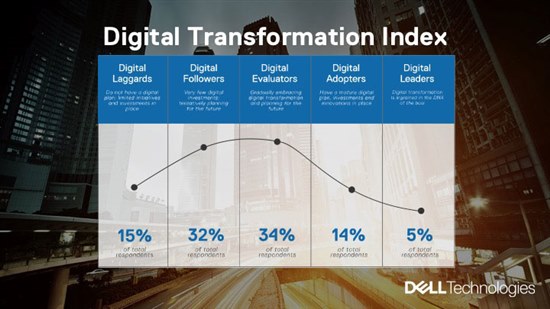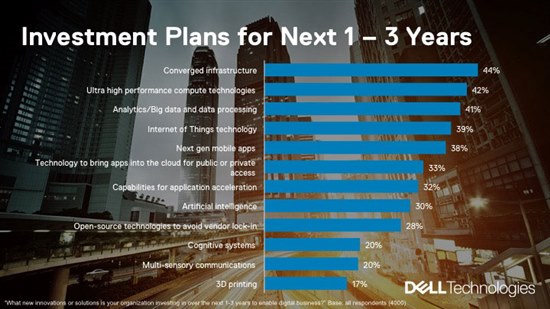Recently I wrote of how the next Industrial Revolution is upon us – it’s a revolution that will impact every company in every industry. It’s a revolution that potentially threatens the existence of most household names we know today, but one that’s also rich with opportunity.

For incumbents to play a part they must transform – their business, their approach to IT, their workforce, their security posture – everything. How are businesses reacting to this revolution? We thought it was a question that should be answered. So we commissioned a team of researchers to survey 4,000 business leaders find out.
Today we’re releasing the results of that research – our Digital Transformation Index sponsored by Dell Technologies. What do the results tell us?
First, the revolution is already here, and the pressure is on established companies to act. Fifty-two percent of respondents have already experienced significant disruption to their industries as a result of digital technologies. Seventy-eight percent of respondents consider digital start-ups as a threat, either now or in the future – which in my view suggest that the barriers to entry that used to protect established companies are significantly lower – and perhaps even non-existent in some instances. Strikingly, 48 percent of respondents said they don’t know what their industry will look like in 3 years’ time – a stark contrast to the past when established companies were stewards for their industry and the products and services they delivered to customers.
What did the research suggest about how respondents are reacting to the pressure to transform?
Researchers found that while many organizations have begun to respond, progress is patchy. Researchers plotted the progress of all 4,000 respondents against a digital business benchmark. It shows that there are five types of businesses traveling on the path towards their digital future.
Businesses in the top group – the Leaders – are delivering new customer experiences by writing software to make their products smart or take their services online. They proactively drive change and seek to take control of their digital destiny, delivering on the attributes of a digital business as a result. This group represents just 5 percent of respondents. Companies in the Digital Adopters group – representing 14 percent of respondents – are still doing a stand-up job. They’ve got a pretty mature plan and they’ve implemented a number of programs driving their digital futures. The largest chunk of respondents, 34 percent, find themselves in the Digital Evaluators group and are gradually embracing innovation (‘gradually’ being the operative word). Thirty-two percent are classified as Digital Followers; companies that are still at the very early stages of their journey. They’ve got a lot of catching-up to do. Firms in the Laggard group resist change – their very survival hangs in the balance. They represent 15 percent of respondents. Clearly, the majority of businesses still have a long way to go in the digital journeys.
What are respondents planning to do to accelerate their transformation?
I’ve always maintained that for many companies IT transformation is at the heart of a digital transformation – the research confirms this: 73 percent are in agreement that a centralized technology strategy needs to be a priority for their business and 66 percent are planning to invest in IT infrastructure and digital skills leadership. It’s also been my view that every company, in every industry is going to become a software company, or establish software DNA at their core. So it comes as no surprise to me that almost three in four (72 percent) of respondents are now expanding their software development capabilities in order to advance their digital business transformation.
Suffice it to say, the majority of businesses are only beginning their digital transformation. If you’re a part of this majority, is it too little, too late? No, of course not. While the revolution is here, it’s nowhere close to complete. The opportunity is and will continue to be massive. But the time to act is now. One good way to get going is to simply explore the results of the research and see how you stack up against 4,000 of your peers: check out the full results here.

